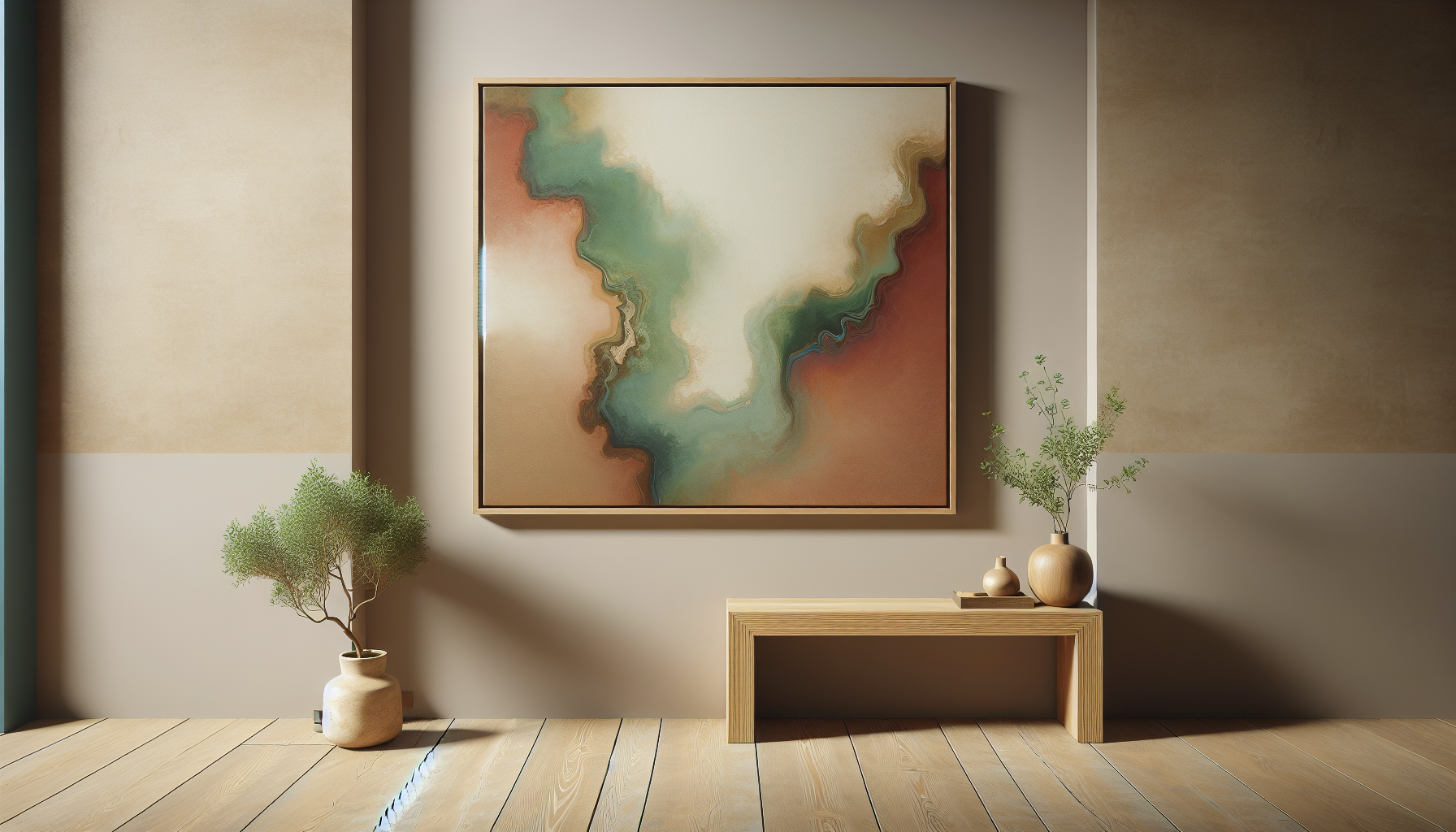Have you ever found yourself contemplating the compatibility of your extensive art collection with a specific design style? If you’re a fan of the serene simplicity of Japandi style, you might be curious about how it aligns with your passion for art.
Understanding Japandi Style
Japandi style is a harmonious blend of Japanese and Scandinavian design philosophies. It encapsulates minimalism, functionality, and a distinctive appreciation for craftsmanship. This style emphasizes clean lines, natural materials, and neutral color palettes, creating a peaceful, uncluttered environment that promotes mindfulness and relaxation.
Characteristics of Japandi Style
To better understand how your art collection might fit into Japandi design, let’s take a closer look at its defining features:
-
Minimalism: Japandi embraces the idea of ‘less is more.’ It favors open spaces and a limited number of decorative items that carry significance.
-
Natural Elements: You’ll often find a focus on wood, stone, and organic textiles. These materials bring a sense of warmth and connection to nature.
-
Neutral Color Palette: Think soft beiges, whites, greys, and muted tones. These colors promote a soothing ambiance that can serve as a natural backdrop for more vibrant artwork.
-
Functional Design: Each piece in a Japandi space is chosen for its function as well as its aesthetic, blending beauty with practicality.
-
Cultural Motifs: Japandi incorporates both Japanese and Scandinavian influences, often highlighting handcrafted pieces that reflect these rich cultures.
By understanding these principles, you can begin to consider how your art collection might seamlessly integrate into a Japandi-inspired environment.
Can Japandi Accommodate Large Art Collections?
The question remains: Can you maintain a Japandi aesthetic while showcasing a substantial art collection? The answer is not as straightforward as it might seem, but with strategic planning and thoughtful selection, it’s certainly possible!
Balancing the Elements
Maintaining a balance is critical in Japandi design, especially when accommodating larger art collections. You’ll want to ensure that your art doesn’t overwhelm the core elements of Japandi style. Here are some tips to keep that balance:
1. Choose Signature Pieces
Instead of displaying every piece in your collection, consider curating a selection of signature artworks. Displaying a few well-chosen pieces will allow them to stand out while still adhering to the minimalist principles of Japandi.
2. Neutral Backdrops
Utilize neutral walls and simple furniture that complements your artworks rather than competes with them. This approach creates a cohesive and serene environment, allowing your art to become focal points without overwhelming the space.
3. Cohesion in Color
Select a color palette for your art collection that echoes the muted tones of Japandi. Artworks featuring earthy colors or subtle hues can blend beautifully into your design, maintaining the serene aesthetic.
Creating Art Zones
In larger spaces, creating dedicated art zones can help manage the flow of your collection. This approach can enhance the Japandi aesthetic while allowing for artistic expression.
1. Gallery Walls
Consider designing a gallery wall that curates several pieces together. You can arrange them in a grid or staggered formation, ensuring a harmonious look while keeping with the Japandi style.
2. Separate Spaces
If your collection is extensive, allocate different areas for different types of artwork. This can be as simple as designating specific walls for sculptures or paintings, keeping each section curated and intentional.
Incorporating Furniture
When displaying large art pieces, furniture plays a vital role. Here’s how to effectively incorporate it without cluttering your space:
1. Minimalist Display Stands
Opt for minimalist display stands or easels that won’t distract from your artwork. Simple, understated designs align well with Japandi principles, maintaining focus on the art itself.
2. Functional Elements
Consider furniture that doubles as display space, such as shelves or cabinets designed to showcase smaller art pieces. This dual purpose can enhance functionality while still promoting a clean aesthetic.
Lighting Considerations
Lighting can dramatically affect the perception of both your art and the surrounding space. In Japandi design, lighting should be coherent with the tranquility of the style.
Natural Light
Maximize natural light whenever possible. Large windows or strategically placed mirrors can help reflect light and create an open feel, allowing your art to benefit from the warmth and vibrancy of natural illumination.
Accent Lighting
Incorporate soft accent lighting focused on specific art pieces. Wall sconces or directional lights can highlight your collection without casting harsh glare, complementing the soft aesthetics of Japandi.
Art Placement Techniques
How you place your art can significantly enhance both your collection and the overall ambiance of your space.
Eye Level Placement
When displaying artwork, keep the pieces at eye level for optimal viewing. This placement invites interaction and ensures your art captures attention as intended.
Grouping Techniques
You can employ various grouping techniques tailored to both the size of the artworks and the space available. Here are a few popular methods:
| Grouping Technique | Description |
|---|---|
| Symmetrical Grouping | Arrange pieces of similar sizes in a balanced manner for a classic, organized look. |
| Asymmetrical Grouping | Use a mix of art sizes for a dynamic, modern feel that can feel more relaxed and spontaneous. |
| Thematic Grouping | Organize artworks by a common theme or color palette. This can create a more cohesive narrative in your collection. |
Personal Touches
Both Japanese and Scandinavian designs value personal storytelling through art. You can maintain the essence of Japandi while adding personal touches that reflect your tastes and experiences.
Meaningful Art
Choose artworks that resonate with you personally. Whether it’s pieces that evoke memories or reflect your values, ensuring emotional connections to your collection embraces the spirit of Japandi.
Handmade Elements
Incorporating handmade or artisanal pieces from either culture can further enhance the character of your space. Look for elements that complement your artwork while adhering to the natural and simplistic aesthetics of Japandi.
Navigating Challenges
You may face some challenges when trying to merge a large art collection with the calming principles of Japandi design. Let’s explore these potential hurdles and how to navigate them.
Avoiding Clutter
One of the biggest challenges will be preventing clutter. Here are a few strategies to manage this issue:
-
Regularly Evaluate Your Collection: Take the time to assess which pieces truly resonate with you and which may be removed to simplify your space.
-
Embrace Seasonal Changes: Rotate the artworks on display to keep things fresh without overcrowding your space. This practice aligns perfectly with Japandi’s focus on renewal and simplicity.
Dealing with Size Constraints
If your space has size constraints, especially in smaller rooms, consider these tips:
-
Vertical Displays: Use vertical wall space creatively. Tall, narrow art pieces or installation-style displays can give the illusion of height without taking up much floor space.
-
Multi-functional Furniture: Incorporate furniture that serves multiple purposes, freeing up wall space for art.
Final Thoughts
Your love for art doesn’t have to be sacrificed for the serene simplicity of Japandi style. By thoughtfully curating your collection, embracing minimalism, and maintaining balance, you can celebrate both your artistic passions and the calming essence of Japandi.
Remember, design is a reflection of you, and there are always ways to make it work harmoniously. Your art collection can coexist beautifully within a Japandi-inspired space, showcasing your unique taste while promoting tranquility and warmth. With a bit of creativity and intention, your home can become a peaceful sanctuary filled with artistic expression.

